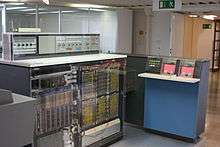Punched card input/output


A computer punched card reader or just computer card reader is a computer input device used to read executable computer programs and data from punched cards under computer control. A computer card punch is a computer output device that punches holes in cards under computer control. Sometimes computer card readers were combined with computer card punches and, later, other devices to form multifunction machines.
Most early computers, such as the ENIAC, and the IBM NORC, provided for punched card input/output.[1] Card readers and punches, either connected to computers or in off-line card to/from magnetic tape configurations, were ubiquitous through the mid-1970s.
Punched cards had been in use since the 1890s; their technology was mature and reliable. Card readers and punches developed for punched card machines were readily adaptable for computer use.[2] Businesses were familiar with storing data on punched cards and keypunch machines were widely employed. Punched cards were a better fit than other 1950s technologies, such as magnetic tape, for some computer applications as individual cards could easily be updated without having to access a computer.
Operation
The standard measure of speed is cards per minute, abbreviated CPM: The number of cards which can be read or punched in one minute. Card reader models vary from 300 to around 2000 CPM.[3] If all columns of an 80 column card encode information this translates to approximately 2500 characters per second (CPS).
Cards may be read using mechanical brushes that make an electrical contact for a hole, and no contact if no punch, or photoelectric sensors that function similarly. Timing relates the signals to the position on the card. Cards may be read serially, column by column, or in parallel, row by row.
Card punches necessarily run more slowly to allow for the mechanical action of punching, up to around 300 CPM or 400 characters per second.[4]
Some card devices offer the ability to interpret, or print a line on the card displaying the data that is punched. Typically this slows down the punch operation. Many punches read the card just punched and compare its actual contents to the original data punched, to protect against punch errors. Some devices allow data to be read from a card and additional information to be punched into the same card.
Readers and punches include a hopper for input cards and one or more stackers for cards read or punched. A function called stacker select allows the controlling computer to choose which stacker a card just read or punched will be placed into.
Card readers/punches
CDC
- CDC 405 — CDC 6000 series card reader
- CDC 415 — CDC 6000 series card punch
Documation
Documation Inc., of Melbourne, Florida, made card readers for minicomputers in the 1970s:
- M-200 card reader, 300 cards/minute[5] also sold by DEC as the CR-11 card reader for the PDP-11[6]
- M-600 card reader, 600 cards/minute
- M-1000-L card reader 1000 cards/minute[7]
IBM
- IBM 711 card reader computer peripheral used in the vacuum tube era
- IBM 2501 card reader
- IBM 1402 high speed reader/punch introduced with the IBM 1401
- IBM 1442 reader/punch introduced with the lower-cost IBM 1440
- IBM 2540 reader/punch derived from the 1402 that was introduced with System/360
See also List of IBM products#Punched card and paper tape equipment
See also
- Plugboard discusses how early card readers worked in some detail.
- Computer programming in the punched card era
References
- ↑ Stern, Nancy (1981). From ENIAC to UNIVAC: An Appraisal of the Eckert-Mauchly Computers. Digital Press. p. 50. ISBN 0-932376-14-2.
- ↑ The IBM 711 Punched Card Reader's card-feeding mechanism was similar to the IBM 402's card-feeding mechanism
- ↑ Roy, Gautam (2007). Computer Studies for Engineering Students. Mumbai, IN: Allied Publishers Limited. p. 10. ISBN 9788184242119. Retrieved July 28, 2016.
- ↑ IBM Corporation (1971). IBM 3505 Card Reader and IBM 3525 Card Punch Subsystem. Retrieved July 28, 2016.
- ↑ Documation M-200 Card Reader Manual, 1972
- ↑ Documation M-200 photo
- ↑ Documation M1000L Card Reader
Punched card equipment
 An IBM 650 computer, introduced in 1953, came with the IBM 533 Card Reader/Punch, right. At many IBM 650 installations, punched cards were the only input and output medium.
An IBM 650 computer, introduced in 1953, came with the IBM 533 Card Reader/Punch, right. At many IBM 650 installations, punched cards were the only input and output medium. IBM 711 card reader on an IBM 704 computer at NASA in 1957
IBM 711 card reader on an IBM 704 computer at NASA in 1957 The popular IBM 1401, introduced in 1959 featured a fast card reader/punch, the IBM 1402, left
The popular IBM 1401, introduced in 1959 featured a fast card reader/punch, the IBM 1402, left IBM 711 card readers, far left and foreground, attached to dual IBM 7090s at NASA Mission Control in 1962.
IBM 711 card readers, far left and foreground, attached to dual IBM 7090s at NASA Mission Control in 1962. An IBM 2540 Card Reader Punch at the University of Michigan computer center in 1968
An IBM 2540 Card Reader Punch at the University of Michigan computer center in 1968 Punched card reader/punch on an IBM System/360 Model 20
Punched card reader/punch on an IBM System/360 Model 20 IBM System/3, announced in 1969 introduced a new, smaller punched card and a combined reader/punch/sorter, right
IBM System/3, announced in 1969 introduced a new, smaller punched card and a combined reader/punch/sorter, right.jpg) IBM 7070 with IBM 7501 Console Card Reader, right, based in the IBM 026 keypunch
IBM 7070 with IBM 7501 Console Card Reader, right, based in the IBM 026 keypunch- Documation M-600 card reader
| Wikimedia Commons has media related to Punch card readers. |